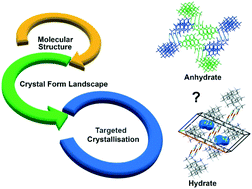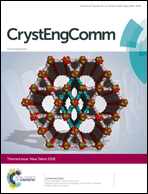From serendipity to supramolecular design: assessing the utility of computed crystal form landscapes in inferring the risks of crystal hydration in carboxylic acids†
Abstract
A set of calculated structural descriptors [% solvent accessible volumes per unit cell (% SAVs), the relative packing index and the estimated distance of polar/non-polar groups on the acid relative to the lattice positions corresponding to crystal voids] were used to assess the utility of predicted crystal form landscapes (CFLs) in warning against the risks of crystal hydration using model carboxylic acids that are known to crystallise as anhydrate, monohydrate and dihydrate crystal phases, respectively. The crystal structures of 1-adamantaneacetic acid and 3-bromoadamantane-1-acetic acid are reported as anhydrates following crystallisation screens for possible hydrates of both. The results show that % SAVs are a poor predictor of crystal hydration as the majority of the predicted anhydrate polymorphs (up to a relative lattice energy range of 10 kJ mol−1) for all systems did not display packings with solvent accessible voids. The relative packing index (ΔPI) of the known hydrates and the set of low energy predicted anhydrate polymorphs was found to be a useful predictor of crystal packing frustration. 4-Oxocyclohexanecarboxylic acid which crystallises as a monohydrate (INOGEX) displayed a CFL where 86% of the predicted anhydrate polymorphs within a relative lattice energy range of 10 kJ mol−1 displayed poorer crystal packings than the monohydrate. By contrast, in 2-pyrone-4,6-dicarboxylic acid which crystallises as a dihydrate (KISJEC), only 15% of predicted anhydrate polymorphs had a lower packing efficiency than the dihydrate, indicating that the crystal hydration for this system is not driven by poor crystal packing of the acid. Careful inspection of the hydrogen bond motifs adopted by the predicted anhydrate polymorphs has shown that crystal hydration in 2-pyrone-4,6-dicarboxylic acid may be driven by the need to satisfy all hydrogen bond donor/acceptor groups on the acid whilst in 4-oxocyclohexanecarboxylic acid, water inclusion is likely to be driven by poor crystal packing of the low energy anhydrate polymorphs for this molecule. The results suggest that careful analysis of the packing efficiencies and the lattice positions of the crystal voids in predicted anhydrate polymorphs can provide clues to the driving force for crystal hydration as well as the types of intermolecular acid–water interactions that may be observed in hydrated crystal forms.

- This article is part of the themed collections: Introducing the CrystEngComm Advisory Board and their research and CrystEngComm New Talent


 Please wait while we load your content...
Please wait while we load your content...